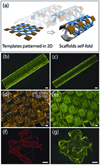Self-folding devices and materials for biomedical applications
- PMID: 21764161
- PMCID: PMC3288299
- DOI: 10.1016/j.tibtech.2011.06.013
Self-folding devices and materials for biomedical applications
Abstract
Because the native cellular environment is 3D, there is a need to extend planar, micro- and nanostructured biomedical devices to the third dimension. Self-folding methods can extend the precision of planar lithographic patterning into the third dimension and create reconfigurable structures that fold or unfold in response to specific environmental cues. Here, we review the use of hinge-based self-folding methods in the creation of functional 3D biomedical devices including precisely patterned nano- to centimeter scale polyhedral containers, scaffolds for cell culture and reconfigurable surgical tools such as grippers that respond autonomously to specific chemicals.
Copyright © 2011 Elsevier Ltd. All rights reserved.
Figures






References
-
- Madou MJ. Fundamentals of microfabrication: the science of miniaturization. 2nd ed. CRC Press; 2002.
-
- Charnley M, et al. Integration column: microwell arrays for mammalian cell culture. Integr Biol. 2009;1:625–634. - PubMed
-
- Desai TA, et al. Microfabricated immunoisolating biocapsules. Biotechnol Bioeng. 1998;57:118–120. - PubMed
-
- Rappaport C. Review—Progress in concept and practice of growing anchorage-dependent mammalian cells in three dimensions. In Vitro Cell Dev Biol Anim. 2003;39:187–192. - PubMed
-
- Santini JT, et al. Microchips as controlled drug-delivery devices. Angew Chem Int Ed Engl. 2000;39:2396–2407. - PubMed
Publication types
MeSH terms
Substances
Grants and funding
LinkOut - more resources
Full Text Sources
Other Literature Sources

